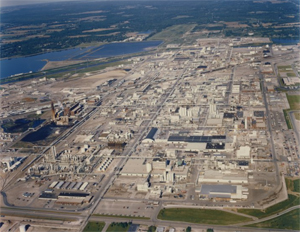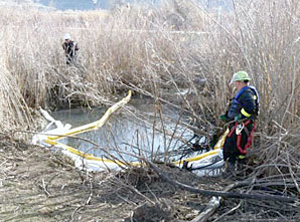From longstanding toxic Superfund sites to newly discovered potential pollution hazards, one of the keys to resolving environmental uncertainty is to accurately assess the risks posed not only to the environment, but to the people. For three decades, TechLaw has effectively addressed risk assessment issues that have touched on numerous environmental issues affecting human health and the environment.
Leaching and mixing, volatilization, biodegradation, dispersion and deposition, food chain effects: they’re incredibly complex environmental issues requiring deep scientific knowledge, along with extensive experience. At TechLaw, our team has addressed virtually every major environmental exposure challenge, covering both naturally-occurring issues and chemical and radiological exposure.
Our background includes:
- Development of provisional toxicity criteria for PFOS/PFOA for the US EPA and the National Center for Environmental Assessment. We have also developed provisional toxicity criteria for several states, such as Kansas, where we developed ingestion and inhalation-based toxicity criteria.
- The creation of hundreds of human health and ecological risk assessments for federal, state and commercial clients, along with assistance in negotiating risk management plans, options and solutions for the spectrum of chemical and radiological exposure.
- In-depth reviews of thousands of environmental risk assessment documents associated with more than 200 CERCLA, RCRA and federal facility sites in all EPA regions, including Alaska, Hawaii, Guam, and the Virgin Islands.
- Development and instruction for several national, regional and state-specific risk assessment guidance and training courses, providing professional development to site mangers and regulators across the country in their management and oversight of investigations, remediation and permitting activities.
Ecological Risk Assessment - National Park Service
Joshua Tree National Park, California
 TechLaw performed field sampling and wrote a baseline ecological risk assessment (BERA) on behalf of the National Park Service (NPS) for a small abandoned gold ore processing facility located in Joshua Tree National Park, CA. Previous investigations by others at this location showed that several metals were potential contaminants of concern for terrestrial receptors and needed further evaluation. The focus of this project was to quantify the risk to plants, invertebrates, small carnivorous birds, and small carnivorous mammals that reside or forage at this desert site, and to derive soil cleanup goals for certain metals, as needed. The BERA focused on small bird and mammal carnivores because they, unlike herbivores or omnivores, feed higher up in the food chain where metals can bioaccumulate.
TechLaw performed field sampling and wrote a baseline ecological risk assessment (BERA) on behalf of the National Park Service (NPS) for a small abandoned gold ore processing facility located in Joshua Tree National Park, CA. Previous investigations by others at this location showed that several metals were potential contaminants of concern for terrestrial receptors and needed further evaluation. The focus of this project was to quantify the risk to plants, invertebrates, small carnivorous birds, and small carnivorous mammals that reside or forage at this desert site, and to derive soil cleanup goals for certain metals, as needed. The BERA focused on small bird and mammal carnivores because they, unlike herbivores or omnivores, feed higher up in the food chain where metals can bioaccumulate.
TechLaw personnel spent five consecutive days at the park, obtaining soil and tissue samples from soil, plants and small mammals, taking care not to harm sensitive native species. TechLaw selected the laboratories for chemical analyses and bioaccumulation testing based on its list of pre-approved vendors.
The BERA identified arsenic, chromium, copper, lead, mercury, and vanadium as the contaminants of concern across the four terrestrial receptor groups at the site. All these metals required soil cleanup goals to support future risk management decision-making by the NPS.
The project met its goals and showed that the proposed risk approach could be applied in a desert environment. The NPS used this project as a pilot study to determine if the proposed field sampling efforts and risk calculation approaches used at this one site could be scaled up to be applied to 13 other more-remote mining sites scattered throughout Joshua Tree National Park.
Dow Chemical Co.
Midland, MI
 TechLaw’s risk assessment team supported US EPA at the Dow facility, a 1,900-acre chemical manufacturing plant. Past waste disposal practices, fugitive emissions, and incineration at Dow resulted in on- and off-site contamination. Contaminants of concern included dioxins and furans, chlorobenzenes, heavy metals, and other byproduct materials resulting from the manufacture of chlorine-based products and other chemicals.
TechLaw’s risk assessment team supported US EPA at the Dow facility, a 1,900-acre chemical manufacturing plant. Past waste disposal practices, fugitive emissions, and incineration at Dow resulted in on- and off-site contamination. Contaminants of concern included dioxins and furans, chlorobenzenes, heavy metals, and other byproduct materials resulting from the manufacture of chlorine-based products and other chemicals.
TechLaw developed a quantitative sensitivity analysis and technical memoranda to define the impact of individual exposure and intake parameters in the estimation of projected carcinogenic risk and development of cleanup criteria. TechLaw’s sensitivity analysis considered routine soil sediment, groundwater, surface water, and air exposures under agricultural, residential, industrial, and recreational land uses. Additional exposure pathways considered infant exposure during breastfeeding and bioaccumulation due to ingestion of fish, deer, turkey, and squirrel within the Tittabawassee River floodplain. The sensitivity analysis utilized University of Michigan Dioxin Exposure Studies that characterize the local background levels and body burdens (demographics). TechLaw also developed “Evergreen” quantitative spreadsheets, allowing EPA to update the exposure and sensitivity assessment as new information becomes available.
TechLaw’s report was used in a negotiated settlement with Dow Chemical.
Chevron Pipeline Diesel Spill - Willard Bay State Park
Box Elder County, Utah
 In 2013, an estimated 25,000 gallons of diesel fuel spilled from a pipeline into a drainage ditch and retention pond in the park, impacting about 7 acres of wetlands. TechLaw performed oversight of the completion of remediation activities on behalf of the Utah Department of Environmental Quality (UDEQ), Division of Water Quality (DWQ). On behalf of DWQ, TechLaw prepared a Quality Assurance Project Plan (QAPP) for the collection of soil/sediment and surface water samples to support both a Human Health Risk Assessment (HHRA) and Screening Level Ecological Risk Assessment. (SLERA). TechLaw collected the environmental samples and prepared the Draft HHRA and Draft SLERA. Chevron later paid a $5.35 million settlement to the State of Utah, while Chevron spent more than $20 million in related cleanup costs.
In 2013, an estimated 25,000 gallons of diesel fuel spilled from a pipeline into a drainage ditch and retention pond in the park, impacting about 7 acres of wetlands. TechLaw performed oversight of the completion of remediation activities on behalf of the Utah Department of Environmental Quality (UDEQ), Division of Water Quality (DWQ). On behalf of DWQ, TechLaw prepared a Quality Assurance Project Plan (QAPP) for the collection of soil/sediment and surface water samples to support both a Human Health Risk Assessment (HHRA) and Screening Level Ecological Risk Assessment. (SLERA). TechLaw collected the environmental samples and prepared the Draft HHRA and Draft SLERA. Chevron later paid a $5.35 million settlement to the State of Utah, while Chevron spent more than $20 million in related cleanup costs.
